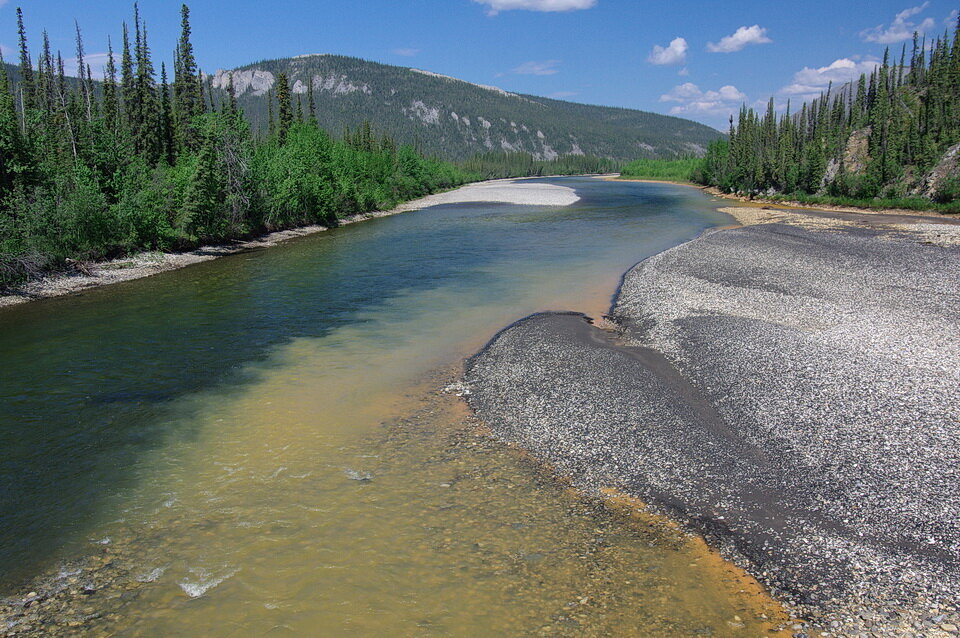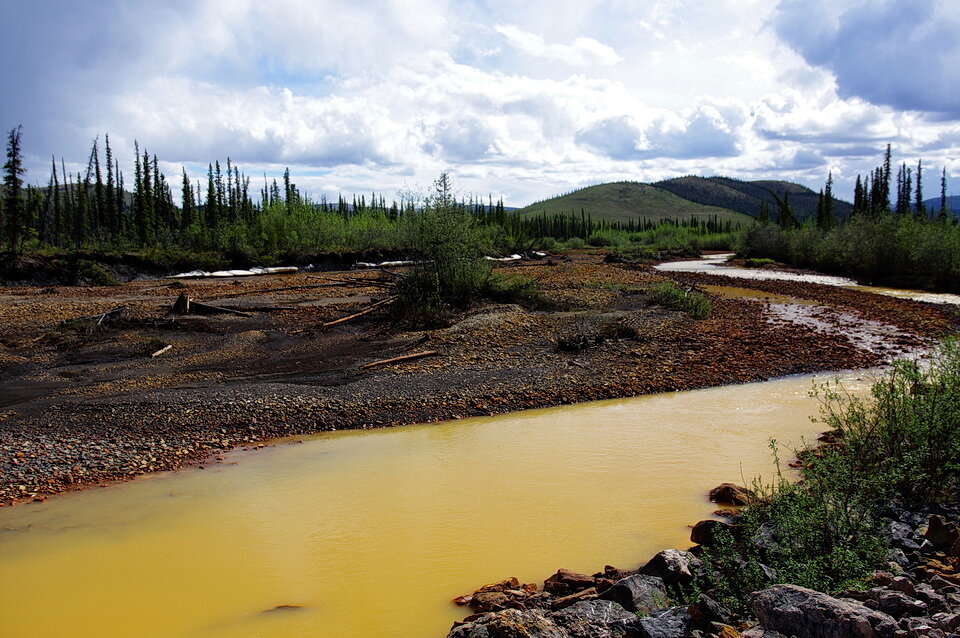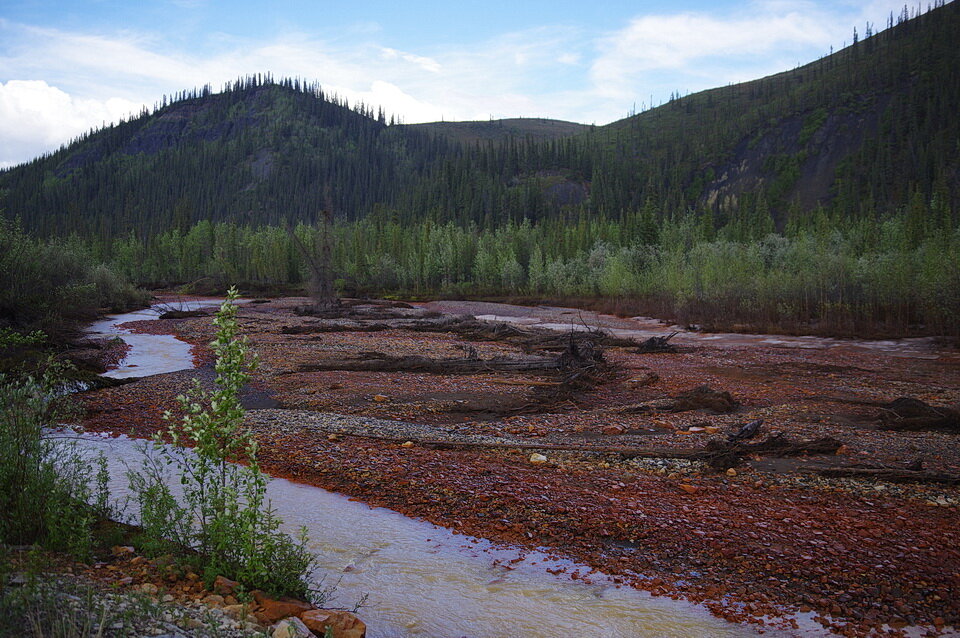Yukon: Tale Of Two Creeks, Yukon, Canada
Convergence of the clear Ogilvie River, on the left, with the metal-rich, yellow-coloured Red Creek, on the right. The local geology influences the chemistry and colour of each water body. Photo composed by Andy Fyon, along the Dempster Highway, central Yukon, Canada, June 22, 2019.
Pollution or Not?
Many dictionaries define “pollution” as the introduction of contaminants into the natural environment that cause adverse change. But what is a contaminant? Again, many dictionaries state that a “contaminant” is a substance that makes something less pure or makes it poisonous.
While many dictionaries don’t discuss if the pollution or contaminants are the result of human activities, we have come to associate the word “pollution” with human activities. But, not all contaminants are caused by human activities.
Red Stain - Yellow Water
Nature can transform natural materials into a form that causes an adverse change to a local environment, and as such, is a form of natural pollution.
A natural example occurs along the Dempster Highway, in central Yukon. Long stretches of Red Creek, central Yukon, are characterized by yellowish-coloured water (Photo 1). Parts of Engineer Creek in the same area also displays these same features.
Photo 1: The yellow-coloured water of Red Creek, central Yukon, is the result of iron minerals that are carried in suspension. The orange-red stain on the surface of the river cobbles is the result of iron minerals that formed a scale, or precipitate, on the rock as the creek water reacts with the atmosphere. The high concentrations of the metals and sulphur in the creek water is the result of reaction between groundwater and black shale in the area. Photo composed by Andy Fyon, along the Dempster Highway, central Yukon, June 12, 2019.
In addition, the river bed cobbles are stained orange-red and some of the vegetation along the edge of Red Creek is dead (Photos 1 and 2).
Photo 2: The orange-red colour of the iron stain, or scale, on the river cobbles in Red Creek, Central Yukon, is the result of iron minerals that formed a scale, or precipitate, on the rock surface. The stain forms as the creek water reacts with the atmosphere. Photo composed by Andy Fyon, along the Dempster Highway, Central Yukon, June 12, 2019.
Perhaps you are thinking that orange-red stain and yellow water must be a sign that something has gone very wrong, likely due to human activity. But, you would be wrong - at least regarding the human role. The orange-red stain and the yellow-coloured water is all natural.
Chemistry At Work
The water of Red Creek contains very high dissolved concentrations of metals like iron, nickel, zinc, and also sulphur. When the creek water flows along the surface, exposed to the atmosphere, those elements become unstable in the water. The elements precipitate out as a scale on the surface of the rock cobbles. The elements also form tiny grains minerals that are suspended within, and carried along by, the creek water. The suspended minerals give the creek water its yellowish colour. Iron minerals are the cause of most of the stain and the yellow water.
So that explains the orange-red rock stain and the yellow water, but how did the creek become so rich in these elements?
Geochemistry to the Rescue
Where did the elements come from? In this area, there is a lot of black-coloured, sedimentary shale rock (Photo 3).
Photo 3: The area around Red Creek is underlain by a variety of rock, including black shale. The black shale is interlayered with thinner beds, or layers, of dolomite rock. The black shale contains elevated concentrations of metals, like nickel, zinc, and iron, and contains elevated concentrations of sulphur. Photo composed by Andy Fyon, along the Dempster Highway, June 12, 2019.
The black shale formed on the bottom of a deep ocean, a long time ago, where there was little or no oxygen. Because of these oxygen-deficient, or anoxic, conditions, all sorts of interesting metals like iron, nickel, zinc, and other elements like carbon (the black rock colour) and sulphur were naturally concentrated in the shale when the shale sediments accumulated initially. Over millions of years, the black sediments, which accumulated on the bottom of the ancient ocean, were buried, heated (metamorphosed), and transformed into shale. Ultimately, the black shale was brought back to surface by great geological forces, where we see it today.
Once on, and near the land surface, the black shale is exposed to the atmosphere and surface waters derived from rain and melting snow. The surface waters enter the ground where they become groundwater. The groundwater reacts with the black shale rock. Metals and other elements contained in the black shale are transferred into the groundwater - geochemistry at work!
Eventually, the metal-rich groundwater flows out onto the surface of the land as a spring, or seep, where more geochemistry happens. Many of the elements dissolved in the spring water become unstable and precipitate out as an orange-red stain on cobbles. Other elements precipitate out to form tiny mineral grains, which are suspended in the creek water. I am leaving out a lot of detail, but you get the idea!
Watershed Tale Of Two Creeks
The geology of a watershed strongly influences the chemistry of the local groundwater. This is really well illustrated where the yellow-coloured water of Red Creek, on the left, represents the geology of a watershed containing metal-rich black shale. A second creek with clear water reflecting the blue sky, on the right, represents the geology of a different watershed that does not contain black shale. Where the two different creeks flow together, their colour difference, and hence watershed difference, is distinctive (Photo 4).
Photo 4: The yellow-coloured water of Red Creek, on the left, reflects the bedrock geology of a watershed containing metal-rich black shale. The clear blue water of the creek on the right reflects the geology of a different watershed that does NOT contain black shale rocks. Alternatively, groundwater springs that feed the blue water creek were isolated from any black shale bedrock. The colour contrast is dramatic where the two creeks flow into each other. Photo composed by Andy Fyon, along the dempster Highway, central Yukon, June 22, 2019.
And there you have the tale of two creeks and the story each can tell us.
Have A Question About This Note?
Andy Fyon, June 14, 2020





